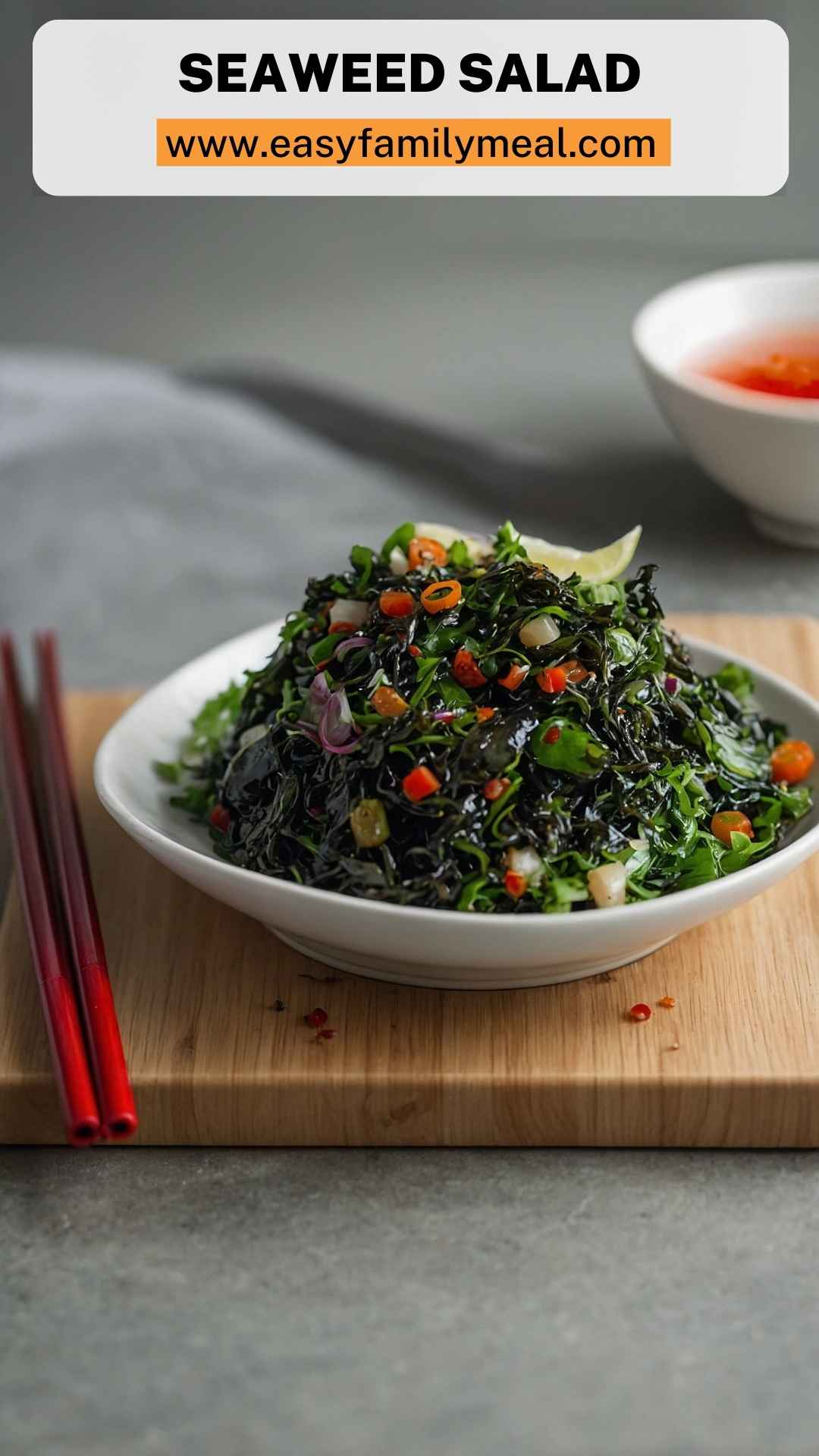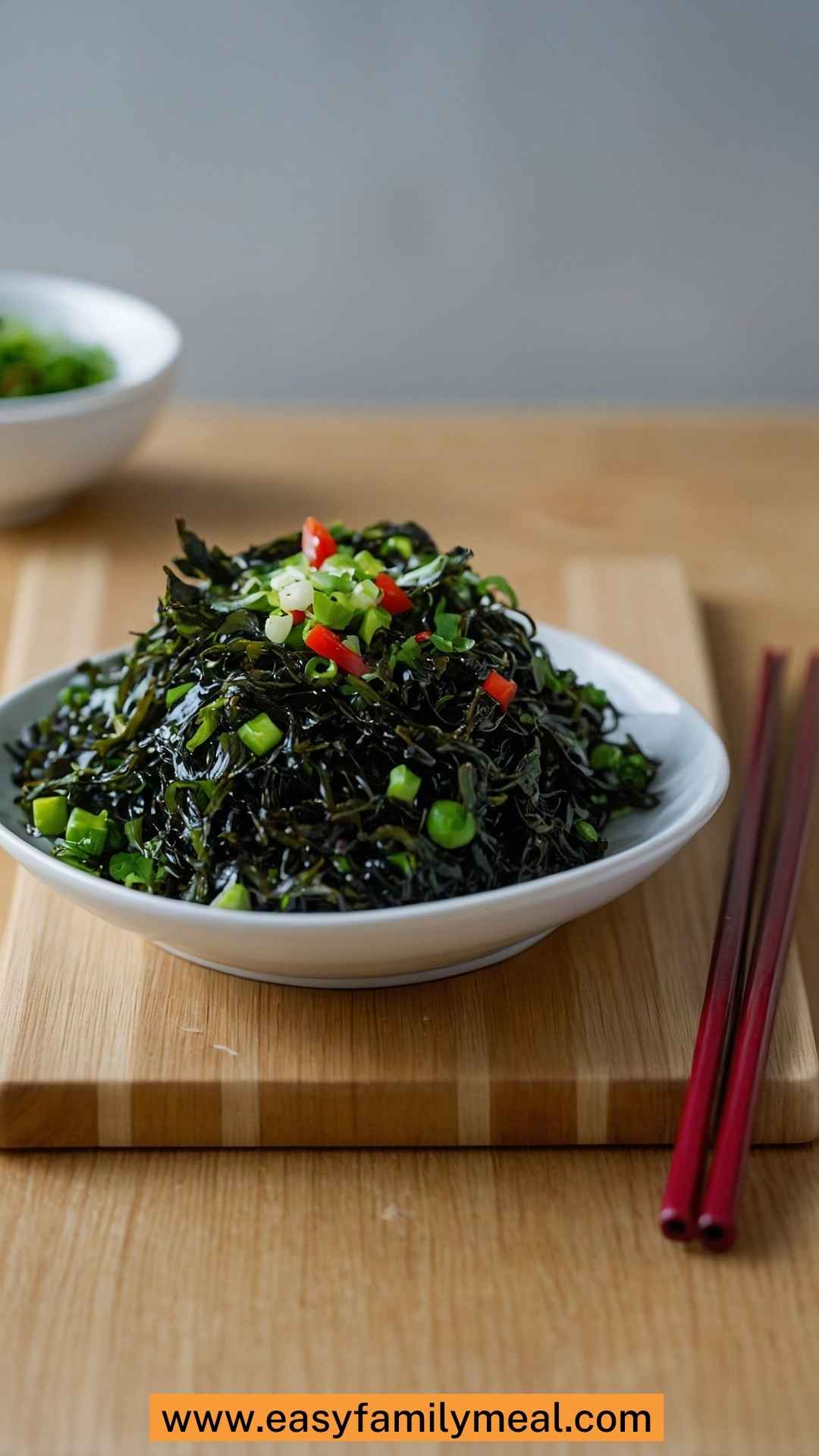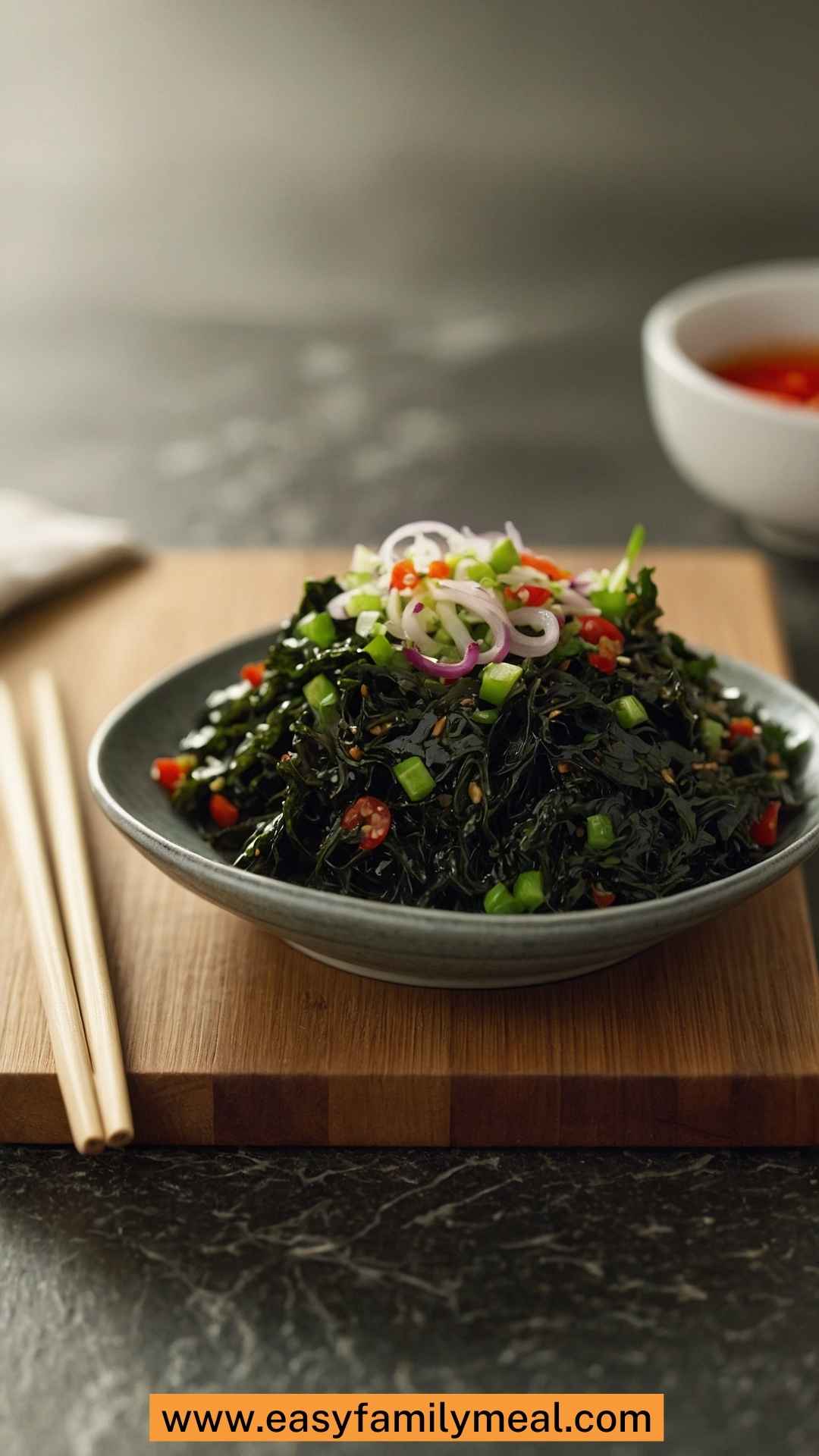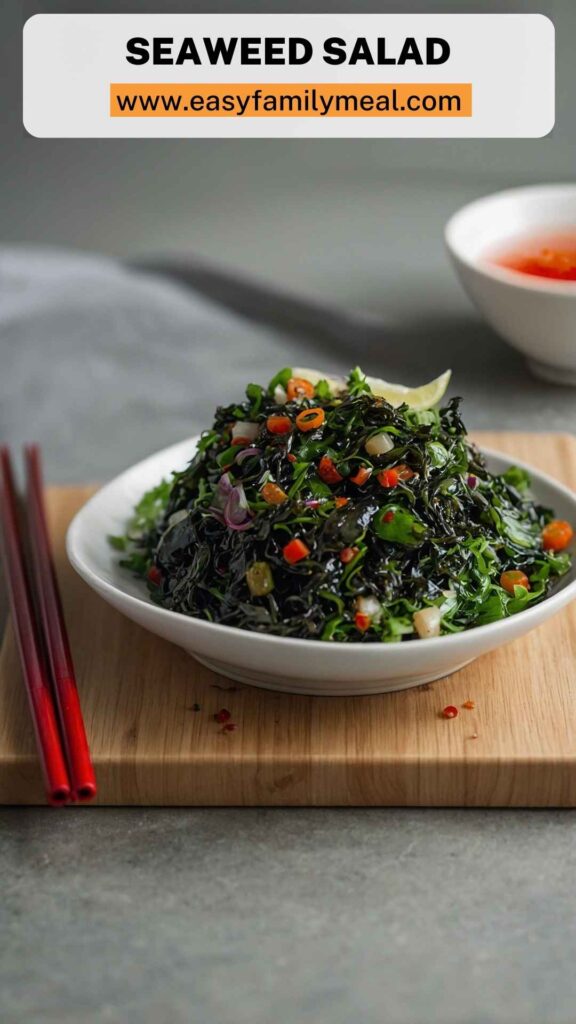Before we dive (pun intended) into creating a delicious seaweed salad, let’s talk about what goes well with this dish. Seaweed salad is a versatile side that pairs beautifully with various foods.
Sushi is an obvious choice. The fresh flavors of sushi enhance the seaweed’s umami kick. Grilled fish, whether salmon or tuna, complements the dish perfectly. The lightness of seaweed salad balances the richness of grilled protein.
Looking for a plant-based option? Consider rice bowls. A bowl filled with brown rice, grilled vegetables, and your seaweed salad can create balance and harmony. For a more substantial meal, serve it alongside ramen. The complex flavors in ramen broth marry nicely with the refreshing seaweed.
Lastly, let’s not forget kebabs. You can enjoy these juicy bites alongside a refreshing seaweed salad for an explosion of flavors. Now that we’ve set the table, let’s get into the good stuff.

What is Seaweed Salad?
Seaweed salad is a traditional Japanese dish that incorporates edible seaweed, often wakame, tossed in a dressing made from sesame oil, soy sauce, vinegar, and sometimes citrus juice. The combination results in a savory and slightly tangy flavor. It’s often served cold and can vary in texture from crunchy to chewy, depending on how it’s prepared.
This dish is often garnished with sesame seeds, scallions, or even additional vegetables for added depth.
What Makes This Recipe Different From Other Seaweed Salad Recipes?
The beauty of this recipe lies in its simplicity and the quality of ingredients. Many seaweed salads use pre-packaged dressings full of preservatives. However, this version relies on fresh ingredients, including yuzu or lemon juice and high-quality sesame oil, ensuring every bite packs a flavorful punch.
Additionally, this recipe includes grated ginger and shallots, giving a delightful twist that outshines many bland variations. The combination creates a fresher taste and a more vibrant presentation, making it a standout choice.
How Does It Taste?
Picture this: you take a bite, and the flavors explode in your mouth. The first taste you’ll get is the umami from the seaweed, followed by the warm nuttiness of the toasted sesame oil. The slight tang from rice vinegar and yuzu brightens the dish, while the ginger adds a zesty kick. The textures vary from the crunchy sesame seeds to the chewy seaweed, creating a delightful experience with every forkful.
Ingredients You’ll Need to Make This Dish
To create this delicious seaweed salad, you’ll need the following ingredients:
- 2 tablespoons naturally brewed soy sauce: This adds depth.
- 35 g dried wakame seaweed: The star of the dish.
- 1 small knob fresh ginger, finely grated: This gives a fresh kick.
- ½ teaspoon white sesame seeds, lightly toasted: For crunch.
- 600 ml filtered water at room temperature: To rehydrate the seaweed.
- 1 tablespoon yuzu juice (or fresh lemon juice as a substitute): Adds brightness.
- 2 stalks scallions (green onions), thinly sliced: For a mild onion flavor.
- 1 teaspoon rice vinegar: Brings acidity.
- 1 shallot, finely minced (optional): For a subtle sweetness.
- 2 tablespoons toasted sesame oil: Gives richness and depth to the salad.

Step by Step Instructions
Step 1: Prepare the Seaweed
Start by placing the dried wakame in a bowl. Cover it with 600ml of room temperature water. Let it soak for about 10-15 minutes. You will notice the seaweed swelling and expanding into soft, plump pieces. After it’s rehydrated, drain and gently squeeze to remove excess water.
Step 2: Make the Dressing
In a separate small bowl, combine the soy sauce, yuzu juice, rice vinegar, and toasted sesame oil. Whisk them together until well blended. This dressing will transform your salad from mundane to magical.
Step 3: Mix in Flavor
Add the finely grated ginger and minced shallot (if using) to the dressing. Stir it all together. The ginger gives an invigorating kick, while the shallot adds a subtle sweetness that complements the other flavors.
Step 4: Combine
In a large bowl, place the rehydrated wakame seaweed, sliced scallions, and the dressing. Toss everything together to ensure the seaweed gets coated well. Make sure all the leaves are dressed evenly.
Step 5: Garnish
Top your salad with toasted white sesame seeds. These seeds not only provide a lovely crunch but also enhance the dish’s visual appeal.
Step 6: Chill
For the best flavor, let your salad chill in the refrigerator for about 30 minutes. This rest time allows all the flavors to meld together beautifully.
Tips & Tricks On Making Seaweed Salad Recipe
Quality Ingredients Matter: Always use high-quality soy sauce and sesame oil. The better the ingredients, the better the flavor.
Adjust Dressing to Taste: Start with the recommended amounts for the dressing but feel free to tweak it. Add more vinegar or soy sauce if you wish for a tangier or saltier taste.
Fresh is Best: If possible, use fresh ginger rather than pre-ground. The flavor is much more vibrant and will elevate your dish.
Add Crunch: Consider tossing in sliced cucumbers or radishes for an extra crunch. These add freshness along with additional texture.
Storage Savvy: Seaweed salad can be stored in the refrigerator for up to three days. However, it’s best enjoyed fresh.
Nutrition Information
Seaweed salad is not just tasty but also packed with nutritional benefits. Here are some key facts:
- Calories: Approximately 150 calories per serving.
- Protein: 4g, thanks to the seaweed and any additional ingredients you might choose.
- Fiber: Seaweed is rich in dietary fiber, aiding digestion.
- Vitamins: High in vitamins A, C, E, and K.
- Minerals: Abundant in calcium and iodine, beneficial for thyroid function.
How Do I Store This Dish?
To store your seaweed salad, follow these steps:
Refrigerate: Place the salad in an airtight container. This will keep it fresh for a couple of days.
Consume Quickly: Though it can last for up to three days, the texture might change as the seaweed absorbs moisture. It’s best to eat it fresh for the best experience.
What Other Substitutes Can You Use in Seaweed Salad Recipe?
Kombu: Similar to wakame but has a thicker texture. It can be used in place of wakame for a different flavor profile.
Spinach: Yes, spinach can bring a fresh green flavor. Use blanched spinach for a different approach.
Cucumber Noodles: If you want crunch and freshness, spiralized cucumbers work well. They add texture and help balance the flavors.
Edamame: For protein, toss in some shelled edamame. They’re a nutritious addition and provide a pop of green.
Shredded Carrots: Brighten the salad with color and sweetness. The carrots can bring a satisfying crunch.

Conclusion
There you have it! A delicious and fresh seaweed salad that even skeptics might crave. It’s easy to make and adaptable based on your preferences. Whether you serve it as a side dish with sushi or as a refreshing salad in its own right, I hope you enjoy making it as much as I did.
This recipe brings out the best in seaweed while offering a delightful blend of flavors and textures. Plus, it’s packed with nutrients that your body will love. So go ahead, roll up your sleeves, and create something magnificent. It’s not just food; it’s a journey of taste, health, and enjoyment!
If you try the recipe, I’d love to hear your thoughts. Did you add anything special? Share your creations. Happy cooking!
You’ll also like the following recipes!

Seaweed Salad – Easy Family Meal
Description
When I first tasted seaweed salad at a local sushi joint, I was amazed. This dish packed a punch with bold flavors and a delightful crunch. Ever since then, I've been experimenting with different recipes. Seaweed salad is not only tasty, but it’s also healthy. It’s low in calories and rich in vitamins like A, C, E, and K, not to mention minerals, especially iodine.
Many people overlook seaweed, thinking it’s only for sushi rolls. In reality, seaweed is a nutritional powerhouse and a versatile ingredient. With this recipe, I'm excited to take you through making a delicious seaweed salad that’s simple, fresh, and full of flavor.
Ingredients
Instructions
Step 1: Prepare the Seaweed
-
Start by placing the dried wakame in a bowl. Cover it with 600ml of room temperature water. Let it soak for about 10-15 minutes. You will notice the seaweed swelling and expanding into soft, plump pieces. After it’s rehydrated, drain and gently squeeze to remove excess water.
Step 2: Make the Dressing
-
In a separate small bowl, combine the soy sauce, yuzu juice, rice vinegar, and toasted sesame oil. Whisk them together until well blended. This dressing will transform your salad from mundane to magical.
Step 3: Mix in Flavor
-
Add the finely grated ginger and minced shallot (if using) to the dressing. Stir it all together. The ginger gives an invigorating kick, while the shallot adds a subtle sweetness that complements the other flavors.
Step 4: Combine
-
In a large bowl, place the rehydrated wakame seaweed, sliced scallions, and the dressing. Toss everything together to ensure the seaweed gets coated well. Make sure all the leaves are dressed evenly.
Step 5: Garnish
-
Top your salad with toasted white sesame seeds. These seeds not only provide a lovely crunch but also enhance the dish’s visual appeal.
Step 6: Chill
-
For the best flavor, let your salad chill in the refrigerator for about 30 minutes. This rest time allows all the flavors to meld together beautifully.
Nutrition Facts
Servings 6
- Amount Per Serving
- Calories 150kcal
- % Daily Value *
- Protein 4g8%
* Percent Daily Values are based on a 2,000 calorie diet. Your daily value may be higher or lower depending on your calorie needs.
Note
- Quality Ingredients Matter: Always use high-quality soy sauce and sesame oil. The better the ingredients, the better the flavor.
- Adjust Dressing to Taste: Start with the recommended amounts for the dressing but feel free to tweak it. Add more vinegar or soy sauce if you wish for a tangier or saltier taste.
- Fresh is Best: If possible, use fresh ginger rather than pre-ground. The flavor is much more vibrant and will elevate your dish.
- Add Crunch: Consider tossing in sliced cucumbers or radishes for an extra crunch. These add freshness along with additional texture.
- Storage Savvy: Seaweed salad can be stored in the refrigerator for up to three days. However, it’s best enjoyed fresh.





